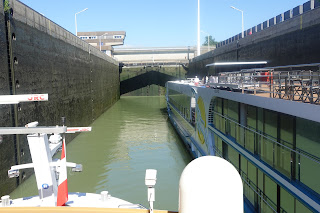Melk Abbey and the Wachau Valley
Monasteries are often tucked away from the outside world but this Benedictine Abbey is perched on a hill overlooking the town of Melk and is visible from many angles.
A view of the abbey from the ship.A view of the abbey from the landward side.
Some of the outer walls of the abbey.
The entrance to the main complex.
The first courtyard.We had a tour through the Imperial apartments but no photos were allowed but it culminated in a magnificent banqueting hall full of marble and gold leaf. The ceiling is flat but clever paint work made it appear as an optical illusion of a curved surface.
We emerged from the banqueting hall onto a terrace and were able to see the west facade of the abbey church. The main facade was flanked by two identical wings. The northern wing houses the library. There are eight rooms but the first one houses 16,000 manuscripts.
A view from the terrace of the footbridge over the Melk River. A view of the local parish church from the terrace.
A view down the Melk River to where it joins the Danube and my ship moored near the mouth.
We were left to wander back at our own speed for an hour through the old town and do whatever shopping and sight seeing we wanted.
Then it was back on board sail down the Wachau Valley, a picturesque section of the Danube.
Another view of the valley.
A scar on the valley sides where a landslide occurred.
One of the churches along the route, but note that the spire has been replaced by battlements as it served as a defensive location in times of unrest and conflict.
Unlike the lower Rhine where even steep slopes were cultivated with vines, the slopes here only have thin soils and so the slopes are terraced to retain the soil to allow vines to grow.Vines are grown on the southern facing slopes but the northern facing slopes receive less sun so are mainly given over to growing orchards. The area is known for growing apricots such as the orchard in the centre of the photo.
On the far right of the photo is a local ferry but it has no engine. It is there'd by a cable to a high level cable upstream and uses the force of the flow of the river and its rudder to glide across the river.
The tower holding the cable can be seen right of centre and the cable over the river in the top centre of the photo.
A magnificent view of a palace.
An iconic view of the ruined Dürnstein Castle and the blue tower of the parish church in the foreground. Dürnstein Castle is where Richard the Lionhearted was imprisoned on his return from the Third Crusade to Acquitane in France, then an English possession and he would be home.

The first bridge over the river since leaving Melk at Förthof.
























No comments:
Post a Comment